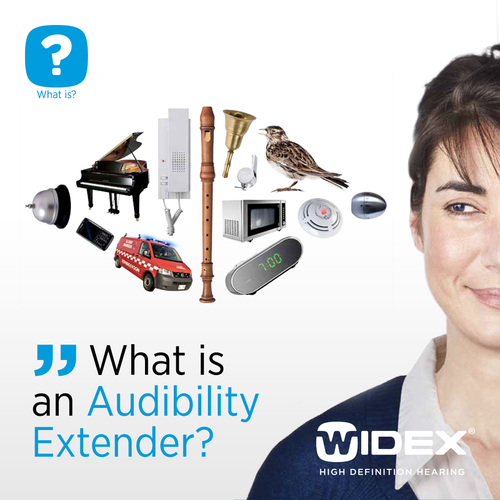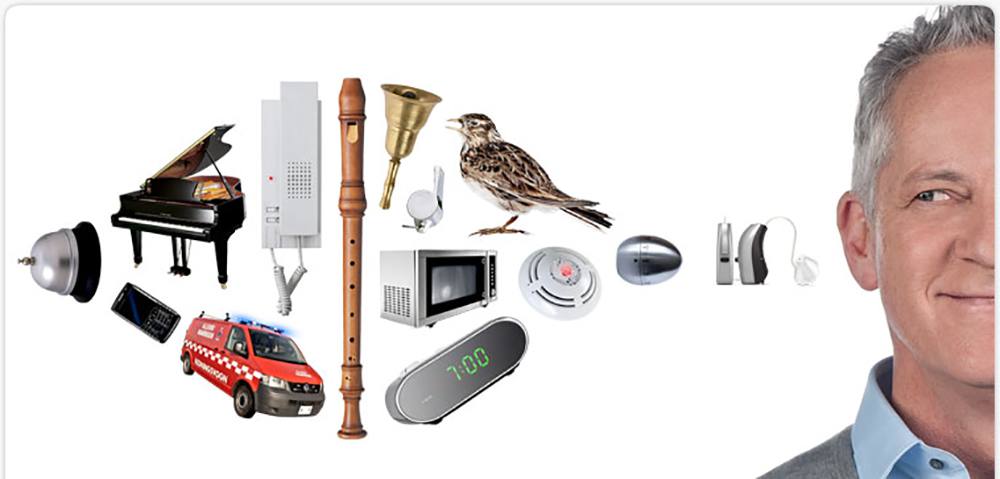Hearing Aids With A Frequency Lowering Feature
Hearing Aids For High Frequency Hearing Loss
 Most people with hearing loss have the bulk of it, or the worst of it in the high frequencies. This is probably the most common type of a hearing problem and it is mainly responsible for the difficulty that many have with the clarity of words in speech. The most important parts of speech for clarity are the consonants of speech which are all high frequency sounds. The consonants of speech are sounds like /s/, /k/, /th/, these sounds give the words their clarity.
Most people with hearing loss have the bulk of it, or the worst of it in the high frequencies. This is probably the most common type of a hearing problem and it is mainly responsible for the difficulty that many have with the clarity of words in speech. The most important parts of speech for clarity are the consonants of speech which are all high frequency sounds. The consonants of speech are sounds like /s/, /k/, /th/, these sounds give the words their clarity.
When you lose some of your high frequency hearing, these sounds are not very audible. In most cases, hearing aids correct the problem, allowing the wearer to hear those hard-to-hear consonants. Making speech much clearer. However, sometimes the damage to the high frequency hearing is too severe or total and normal hearing aids don't and can't help.
This type of severe or total damage is a feature of noise induced hearing loss (NIHL) in particular, with NIHL we would often see very severe high frequency hearing loss greater than 75 to 80 dB. Occasionally we would see people with absolutely little or no high frequency hearing, traditionally, in cases like this, there were only two things that we could do.
Turn Up or Turn Off The High Frequencies
We could either amplify to the high frequencies in the hope that we might deliver some usable sound. What we often found though, was that this wasn't nearly as effective as it should have been for two very different reasons. The first reason was that hearing aids usually couldn't handle it, the feedback management system couldn't manage and they squealed a lot. When this happened of course it interfered with any ability to hear sound and just embarrassed people. The wearer would turn the volume on the hearing aids down because of the whistle, the whistle would go away but so would a large part of the ability to hear. However, even when feedback management became really good at handling high frequency amplification, it became obvious that the amplification was not delivering the benefit that was expected.
It seemed that although some people responded to high frequency tones during a hearing test, when given amplification they didn't do as well as it seemed they should have. Eventually our profession discovered that we were dealing with completely dead regions in the cochlea (inner ear). That neatly brings us to the the turning off. Sometimes people complained that the sound wasn't any clearer, it was distorted, and understanding speech was even more difficult. We now know that in most cases it was because of the dead regions in the cochlea. So to reduce or avoid these problems what we did was in essence cut the gain to the high frequencies. We just gave little or no amplification past a certain frequency in hearing. Neither of the strategies were ideal, neither delivered real clarity of speech, but, many people with severe to profound high frequency hearing loss were satisfied with one of the above approaches.
Frequency Lowering, The Third Way
Now to the meat of the story, there was an additional strategy called frequency lowering, the strategy has been around for quite a long time. However, initially it wasn't a great feature because of the technology that we had available. However, it has seen a huge resurgence in the last fifteen years brought on by the advances in the digital signal processing. So lets talk about frequency lowering and all it's flavours.
Frequency lowering, transposition, compression, & shifting
Those are four seperate names for four quite different features that use different ways to deliver the same outcome. These features can be found in the hearing aids of different manufacturers, while they all try to reach the same goal, they work in very different ways. How they do it is pretty techy, we won't try to bore you, however, if you do want to know the details, call us and we will arrange the information for you. What these features do is make those inaudible high frequency sounds audible, how they do it is by presenting them to you at a lower frequency. Let me explain.
We find out where the problem areas in your high frequency hearing are, we then set the point at which your hearing deteriorates in the software of the hearing aid. When we do this, the hearing aid knows that any sounds that fall into the area where your hearing isn't really viable, need to get presented at a lower frequency where you can hear. These sounds are presented exactly as they should be in order that they deliver the sound information that you need just at a lower frequency. Allowing you an easier time hearing them and a better understanding of speech. Those are the benefits, now let's look at the challenges.
The challenges
The hearing aid is altering the original signal and outputting it at a different frequency, this can sound quite odd for the user. Some of the sounds, like /s/ for example, sound quite unusual at first, people often remark that everyone sounds like they are talking with a lisp. The reason for this is because they are hearing those consonant sounds quite clearly, sometimes for the very first time. There is always an adjustment period with any of these features, they help you hear sounds that you haven’t heard in a really long time and that can be a shock.
Initially it can be challenging, but if you stick with it for a few weeks you will get used to it and it will improve your understanding significantly. There is no question that things will sound unusual for a while, however, the benefit of hearing those high frequency sounds outweighs the fact that they don’t quite sound normal. everyone will only sound like Darth Vader for a week and then your sense of that will fade.
Which hearing aid brands offer frequency lowering?
There are several hearing aid manufacturers which offer this as a feature in their hearing aids. Predominantly we would use Widex aids with the Audibility Extender feature, but we have access to all of the manufacturers. There is no downside to buying hearing aids with this feature, if you don’t like it, it can be turned off very easily. Like most hearing aid features, all manufacturers have a different name for their frequency lowering technology, here is a short list of the major hearing aid manufacturers that offer this feature, and what they named it. If you think you may be a candidate for frequency lowering, or if you are interested in trying out the latest hearing aids in Dublin or across Ireland, come and see us at any one of our hearing aid centres in Stillorgan and Fairview, Dublin, Ardee & Letterkenny and clinics across Ireland.
- Phonak: SoundRecover
- Starkey: Spectral IQ
- Widex: Audibility Extender
- ReSound: SoundShaper


